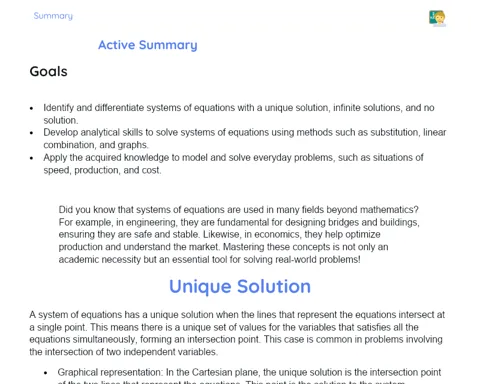Exploring Angular Relationships in Parallel Lines: Theory and Practice
Objectives
1. Understand the relationships between the angles formed by parallel lines cut by a transversal.
2. Solve practical problems involving alternate interior and co-interior angles expressed in terms of x.
Contextualization
The angular relationships in parallel lines cut by a transversal are fundamental not only in mathematics but also in various everyday situations and the job market. For example, when designing a house or a bridge, engineers and architects need to understand these relationships to ensure that structures are safe and aesthetically pleasing. Understanding how angles behave and relate is essential for creating accurate and functional designs.
Relevance of the Theme
Knowledge of angular relationships in parallel lines is crucial in the current context, as it directly applies to fields such as engineering, architecture, and design. Professionals in these areas use these concepts to ensure precision, safety, and beauty in their creations. Furthermore, this mathematical understanding is fundamental for developing logical reasoning and deduction skills, which are valuable in various careers and everyday situations.
Identification of Parallel and Transversal Lines
Parallel lines are two or more lines that never meet, regardless of how far they are extended. A transversal is a line that intersects two or more lines, which may or may not be parallel. Correctly identifying these lines is essential for understanding the angular relationships that form when a transversal intersects parallel lines.
-
Parallel lines never cross.
-
A transversal is a line that intersects two or more lines.
-
Identifying parallel lines and transversals is the first step to analyzing the resulting angular relationships.
Classification of the Formed Angles
When a transversal cuts two parallel lines, several types of angles are formed: alternate interior, alternate exterior, corresponding, internal consecutive, and external consecutive. Each type of angle has specific relationships that can be used to solve mathematical and practical problems.
-
Alternate interior angles are on opposite sides of the transversal, between the two parallel lines.
-
Alternate exterior angles are on opposite sides of the transversal, outside the two parallel lines.
-
Corresponding angles are on the same side of the transversal, one interior and one exterior.
-
Internal and external consecutive angles are on the same side of the transversal, both internal or both external.
Expression of Angles in Terms of x
Often, the formed angles are expressed as equations in terms of a variable, usually x. Solving these equations is an important skill for finding the values of angles and applying these concepts in practical situations, such as in the construction of structures.
-
Angles can be expressed in terms of a variable x.
-
Solving these equations helps to determine the precise values of the angles.
-
This skill is applicable in engineering and architecture problems, where angular precision is crucial.
Practical Applications
- In construction, engineers use angular relationships to ensure the safety and stability of structures, such as bridges and buildings.
- Architects apply these concepts when designing spaces that are aesthetically pleasing and functionally accurate, such as in the arrangement of walls and roofs.
- In graphic design, understanding angles is essential for creating harmonious and balanced layouts, ensuring that visual elements are correctly aligned.
Key Terms
-
Parallel Lines: Two or more lines that never meet.
-
Transversal: A line that cuts two or more lines, which may or may not be parallel.
-
Alternate Interior Angles: Angles that are on opposite sides of the transversal, between the two parallel lines.
-
Alternate Exterior Angles: Angles that are on opposite sides of the transversal, outside the two parallel lines.
-
Corresponding Angles: Angles that are on the same side of the transversal, one interior and one exterior.
-
Internal and External Consecutive Angles: Angles that are on the same side of the transversal, both internal or both external.
Questions
-
How can knowledge of angles in parallel lines help in creating safer and more efficient architectural projects?
-
In what way can precision in measuring and calculating angles influence the aesthetics of a graphic design project?
-
What are the possible consequences of errors in identifying and using angular relationships in engineering projects?
Conclusion
To Reflect
Throughout this lesson, we explored the angular relationships in parallel lines cut by a transversal, a fundamental concept both in mathematics and in various practical applications. We learned to identify and classify different types of angles, such as alternate interior, alternate exterior, and corresponding angles. We also saw the importance of expressing these angles in terms of x, which allows us to solve equations and apply these concepts in real projects.
Reflecting on how this knowledge is applied in fields such as architecture, engineering, and design shows us the importance of mastering these angular relationships. Precision in the measurement and calculation of angles is crucial for ensuring the safety, functionality, and aesthetics of projects. Therefore, by understanding these relationships, we are developing skills that are valuable not only for solving mathematical problems but also for various careers and everyday situations.
Mini Challenge - Practical Challenge: Building a Cardboard Bridge
In this mini-challenge, you will apply the concepts studied to construct a model of a bridge using cardboard. The goal is to use angular relationships to ensure that the bridge is stable and aesthetically pleasing.
- Divide into groups of 4 to 5 members.
- Gather the necessary materials: cardboard, ruler, scissors, glue, protractor, and pencil.
- Plan and draw the model of the bridge, ensuring it has at least one section with parallel lines and one transversal.
- Build the bridge following the drawn plan.
- Identify and mark the alternate interior, alternate exterior, and corresponding angles on your bridge.
- Express these angles in terms of x and solve the formed equations to check the accuracy of the angles.
- Prepare a presentation to explain how you used angular relationships in the project.



